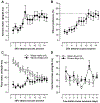Effects of 5-HT2A receptor agonist 2,5-dimethoxy-4-iodoamphetamine on alcohol consumption in Long-Evans rats
- PMID: 33595958
- PMCID: PMC8266736
- DOI: 10.1097/FBP.0000000000000628
Effects of 5-HT2A receptor agonist 2,5-dimethoxy-4-iodoamphetamine on alcohol consumption in Long-Evans rats
Abstract
The objectives of this study were to determine alcohol consumption after administration of (R)(-)-2,5-dimethoxy-4-iodoamphetamine (DOI) or naltrexone in Long-Evans rats, and to assess the effectiveness of these treatments based on individual differences in alcohol consumption. Adult male Long-Evans rats (N = 16) were given opportunities to orally self-administer a 20% (v/v) ethanol (EtOH) solution using an intermittent access, two-bottle (vs. tap water) choice procedure in their home cages. EtOH consumption and preference, total fluid consumption and food intake were measured. Last, we assessed the effects of naltrexone (1 mg/kg; subcutaneous) and (R)(-)-DOI (0.1-1 mg/kg; subcutaneous) on EtOH intake and preference using a quartile analysis. Rats showed stable EtOH (20%) intake and preference after 15 EtOH access sessions. Naltrexone produced a transient decrease in EtOH intake, but an inconsistent effect on EtOH preference, whereas DOI dose-dependently reduced EtOH intake and preference for at least 24 h. Subsequent quartile analyses revealed that rats with the highest EtOH intake during the first 60 min of access to EtOH showed greater reductions in EtOH intake and preference after DOI treatment. This is the first report to show that DOI-elicited reductions in EtOH intake and preference in rats depend on baseline EtOH intake, perhaps supporting a 'baseline dependency' hypothesis of effectiveness with phenethylamine psychedelics on EtOH consumption. If so, individuals with greater potential to develop severe AUDs may be particularly responsive to the positive motivational changes produced by treatment with psychedelics that target the 5-HT2 receptor family.
Copyright © 2021 Wolters Kluwer Health, Inc. All rights reserved.
Conflict of interest statement
Figures




References
-
- Balldin J, Berglund M, Borg S, Månsson M, Bendtsen P, Franck J, Gustafsson L, Halldin J, Nilsson LH, Stolt G, Willander A. (2003). A 6-month controlled naltrexone study: combined effect with cognitive behavioral therapy in outpatient treatment of alcohol dependence. Alcohol Clin Exp Res 27:1142–1149. - PubMed
-
- Bogenschutz MP, Forcehimes AA, Pommy JA, Wilcox CE, Barbosa P, Strassman RJ. (2015). Psilocybin-assisted treatment for alcohol dependence: A proof-of-concept study. J Psychopharmacol 29:289–299 - PubMed
-
- Bruno F. (1989). Buspirone in the treatment of alcoholic patients. Psychopathology 22, Suppl 1: 49–59. - PubMed
Publication types
MeSH terms
Substances
Grants and funding
LinkOut - more resources
Full Text Sources
Other Literature Sources
Medical
Miscellaneous

